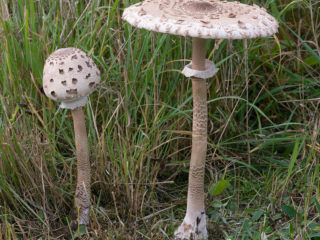Content
Conrad's umbrella is the name of a mushroom of the Champignon family. In Latin it sounds like Macrolepiota konradii. The species forms mycorrhizae with plant roots. Spores germinate due to the absorption of nutrients and organic compounds from the structures of the tree, and the fungus performs the function of breaking down soil humus into amino acids. Such cohabitation is mutually beneficial, so the plants get along well.
Where does Conrad's umbrella grow?
The distribution area of the species is very extensive. It can be found in the middle zone, Transcaucasia. The mushroom grows in forests of various types and is found in open clearings or forest edges. Prefers soil rich in humus and leaf litter.May be seen in city parks. Despite its large distribution area, it is considered a rare species.
Fruiting begins in late summer (in some areas - early autumn) and lasts until October-November. It all depends on the ambient temperature. Therefore, mushroom pickers find separate groups already in June. Grows singly and in small clusters. Pictured is Conrad's umbrella:

Despite its small size, Conrad's umbrella mushroom is very much appreciated among lovers of mushroom dishes.
What does Conrad's umbrella look like?
Only adult mushrooms are suitable for harvesting due to the too small size of young caps. A developed fruiting body has the following features:
The cap reaches a diameter of 5 cm to 12 cm. In a young umbrella it is ovoid, then acquires a semicircular shape, and in an adult mushroom it becomes prostrate. A characteristic feature is a tubercle in the center. The skin is thin, brownish in color, and cracks as the cap grows. A peculiar “star-shaped” pattern is formed on the surface. The pulp is concentrated in the center of the cap and is almost absent at the ends. The color is white, does not change tone when broken.

The original appearance of the cap surface serves as a distinctive characteristic of Conrad
Leg. Tall, the length reaches 10 cm. If weather conditions are favorable, it grows up to 15 cm. The diameter does not exceed 1.5 cm. The leg becomes slightly thicker at the bottom, and there is a club-shaped formation at the base. In young specimens it is solid, in adults it is hollow. The skin on the stem is light brown, smooth, and cracks over time. There is a ring on the leg. Light above, brown below.

To make sure the mushroom you find is edible, you should sacrifice one and cut off the cap.
Plates. Conrad's species belongs to the lamellar species.The plates are frequent, wide and white. Easily separated from the cap.

Be sure to pay attention to the color of the plates to distinguish edible specimens
The spores are whitish-cream.
The taste and smell of the fruiting bodies are pleasant.
Is it possible to eat Conrad's umbrella?
The mushroom has excellent taste characteristics. Considered edible, after cooking it resembles the taste of champignons.
False doubles
Conrad's umbrella has edible and false similar species. To enjoy this particular mushroom, you need to familiarize yourself with the distinctive features of other species:
Motley. Grows larger in size. It has a fibrous cap with a beige color and brown scales. The leg is hollow, fibrous, with a ring. The pulp is white, loose, and is classified as an edible mushroom. The fruiting season coincides, but Variegated is more common on sandy soil.

The cap of the species is very similar, but in Motley it is much larger in size
White. Also edible, it has a fleshy cap that changes shape as the mushroom grows. The leg is hollow, curved, and turns orange when touched. The fruiting period is the same as Conrad's umbrella.

This mushroom is easy to distinguish by the color of the stem if you touch it.
Poisonous Doubles:
The white fly agaric has a skirt on the leg that slides down. Conrad's is static. There is also a volva on the leg, which is absent from the edible umbrella.

It is important to check all the characteristic signs of a poisonous mushroom so that the fly agaric does not end up in the basket
Pale grebe. At a young stage, it can be mistaken for Conrad's umbrella due to the similarity of the caps. Therefore, experienced mushroom pickers do not recommend collecting young umbrellas. Firstly, it will protect against poisoning. Secondly, at this stage the cap is almost without pulp.

Toadstool is a very poisonous mushroom, the signs of which should be known exactly
Rules for collection and use
Basic rules for mushroom pickers:
- Do not take fruiting bodies that are in doubt.
- Avoid places near landfills, garbage heaps, industrial areas, and railroad tracks.
- Collect Conrad's umbrellas only when they are adults, leave the young ones.
- Process the mushrooms as quickly as possible.
- Eat the caps, removing the stems after boiling.
Conrad's umbrellas are classified as dietary mushrooms. The taste of dishes made from them is very pleasant. The nutritional composition is quite diverse; the fruiting bodies contain a large list of useful substances for the human body. If you need to cook mushroom soup, you should not throw away the legs; they give a rich broth. They are removed after boiling. Main dishes are prepared from caps, which are rich in protein. It is not recommended to use umbrellas for people with diseases of the pancreas, intestines, or liver. Nursing mothers and children under 5 years of age should also refrain from eating dishes with umbrellas.
Fruit bodies are suitable for any type of processing - boiling, frying, pickling, pickling, drying.

If one umbrella is found, you need to look nearby for its fellows
Conclusion
Conrad's umbrella is a very nutritious and tasty mushroom. Having studied the main characteristics of the species, you can collect a whole basket of nutritious umbrellas and prepare a lot of dietary dishes.








